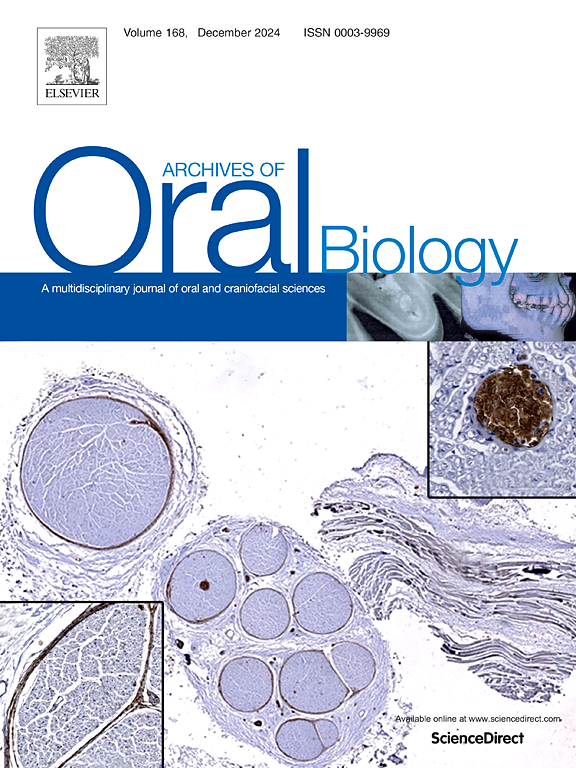Colorimetric and visual assessment of two-color chewing gum mixing ability test: Correlation and reference parameters in dentate subjects
IF 2.2
4区 医学
Q2 DENTISTRY, ORAL SURGERY & MEDICINE
引用次数: 0
Abstract
Objective
This study assessed the chewing performance of dentate subjects, using mixing ability tests with two-colored chewing gums, and aimed to correlate the visual and optoelectronic measurement methods to provide a correspondence scale for predicting the standard deviation of hue (SD-Hue) values based on visual parameters and the number of chewing strokes.
Design
Two chewing gums were used (Hue-Check Gum® and Vivident Fruitswing®), and tests were performed with 1, 5, 10, 15, 20, 25, and 30 chewing cycles. The analysis included optoelectronic analysis to measure the level of color mixture (ViewGum software) expressed as the SD-Hue, ranging from 0 to 1, where lower values correspond to a higher level of mixture, and subjective analysis (SA) on a 5-point ordinal scale. Data analysis included bivariate correlation, definition of double-sided 90 % reference ranges, and GEE regression.
Results
There were significant correlations between SD-Hue and the number of chewing cycles and SA scores (p < 0.001), and SA score was strongly correlated with the number of chewing cycles (p < 0.001). A downward logarithmic curve for SD-Hue and SA can be observed according to the number of chewing cycles. The mixture level progressively increased by approximately 50 % for each five chewing cycles.
Conclusion
It was possible to correlate visual and optoelectronic methods and to establish a scale prediction of SD-Hue values based on SA and the number of chewing cycles. The color mixing measured by optoelectronic and visual methods was proportional to the number of chewing cycles. For every five cycles, the level of color mixture was reduced by 50 %, expressed in a downward logarithmic curve, independently from the chewing gum type.
双色口香糖混合能力测试的比色法与目视评价:齿状受试者的相关性与参考参数
目的通过双色口香糖混合能力测试,评估有齿受试者的咀嚼性能,并将视觉和光电测量方法相关联,为预测基于视觉参数和咀嚼笔划数的色相标准差(SD-Hue)值提供对应量表。设计使用两种口香糖(Hue-Check Gum®和vivid Fruitswing®),分别进行1、5、10、15、20、25和30个咀嚼循环。分析包括光电分析,测量颜色混合水平(ViewGum软件)表示为SD-Hue,范围从0到1,其中较低的值对应较高的混合水平,以及主观分析(SA)在5点序数上。数据分析包括双变量相关、定义双侧90 %参考范围和GEE回归。结果SD-Hue与咀嚼循环次数和SA评分呈显著相关(p <; 0.001),SA评分与咀嚼循环次数呈强相关(p <; 0.001)。根据咀嚼次数,SD-Hue和SA呈对数向下曲线。混合水平在每五个咀嚼循环中逐渐增加约50% %。结论可以将视觉和光电方法相结合,建立基于SA和咀嚼次数的SD-Hue值的尺度预测。光电子法和目视法测得的混合色与咀嚼次数成正比。对于每五个循环,颜色混合水平降低了50% %,以向下的对数曲线表示,独立于口香糖类型。
本文章由计算机程序翻译,如有差异,请以英文原文为准。
求助全文
约1分钟内获得全文
求助全文
来源期刊

Archives of oral biology
医学-牙科与口腔外科
CiteScore
5.10
自引率
3.30%
发文量
177
审稿时长
26 days
期刊介绍:
Archives of Oral Biology is an international journal which aims to publish papers of the highest scientific quality in the oral and craniofacial sciences. The journal is particularly interested in research which advances knowledge in the mechanisms of craniofacial development and disease, including:
Cell and molecular biology
Molecular genetics
Immunology
Pathogenesis
Cellular microbiology
Embryology
Syndromology
Forensic dentistry
 求助内容:
求助内容: 应助结果提醒方式:
应助结果提醒方式:


